The 15 Best Chest Exercises for Strong, Developed Pecs
Most guides to the best chest exercises come up short.
Instead of focusing on time-tested chest exercises, they recommend novel movements that look innovative, but that won’t give you the results you want.
In this article, we’ll chart a different course.
In it, you’ll learn all of the best exercises for chest size and strength, three evidence-based chest workouts, some key insights about chest anatomy, and more.
- 15 Best Chest Exercises for Men and Women
- 1. Bench Press
- 2. Incline Bench Press
- 3. Dumbbell Bench Press
- 4. Incline Dumbbell Bench Press
- 5. Close-Grip Bench Press
- 6. Dip
- 7. Dumbbell Floor Press
- 8. Dumbbell Pullover
- 9. Push-up
- 10. Resistance Band Push-up
- 11. Deficit Push-up
- 12. Decline Push-up
- 13. Resistance Band Chest Press
- 14. Dumbbell Fly
- 15. Cable Fly
- Best Chest Workouts: Exercises, Sets, and Rep Ranges
- Chest Workout for Mass
- Chest Workout for Strength
- Chest Workout for Beginners
- What Are the Muscles of the Chest?
- The Benefits of Doing Good Chest Exercises
- 1. Functional Strength
- 2. Upper Body Aesthetics
- 3. Enhanced Athletic Performance
- Best Exercises for Chest: FAQs
- FAQ #1: Which chest exercise is most effective?
- FAQ #2: What are the only 4 chest exercises I need?
- FAQ #3: How can I get pecs fast?
Table of Contents
15 Best Chest Exercises for Men and Women
1. Bench Press
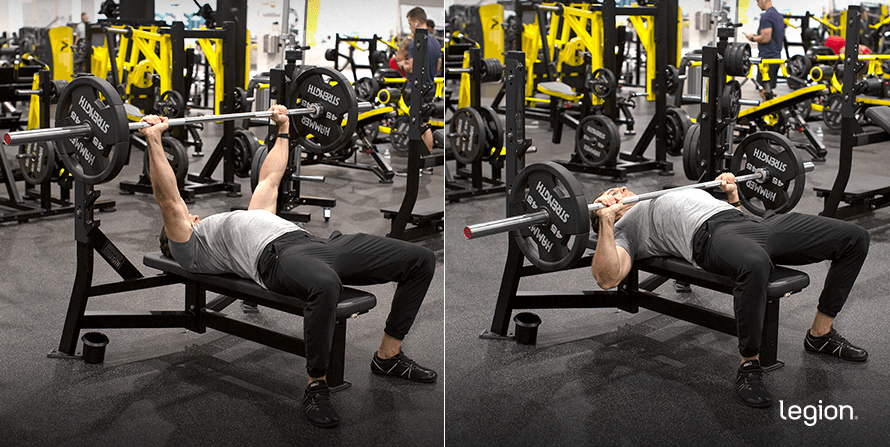
Why: The flat bench press is one of the best exercises for building almost every major muscle in your upper body, especially your pecs, which is why almost all well-designed chest workouts revolve around heavy benching.
How to:
- Lie on a flat bench and place your feet flat on the floor.
- Pull your shoulder blades together and down, and without lifting your butt or shoulders off the bench, slightly arch your back.
- Grab the bar with a slightly wider than shoulder-width grip and unrack the barbell.
- Lower the barbell to your chest, keeping your elbows tucked 6-to-8 inches from your sides.
- Press the bar back to the starting position.
Pro Tip: As you set up for the bench press, imagine screwing your feet into the floor by turning your toes out to the side. This creates tension in your legs, which increases the stability and rigidity of your entire body and ensures you don’t waste energy trying to maintain balance.
Sets and Reps: 3 sets of 4-to-6 reps
Equipment: A bench press station or a squat rack with safety spotter arms and a flat bench, a barbell, and weight plates.
[Read More: How to Increase Your Bench Press: 12 Science-Backed Techniques]
2. Incline Bench Press
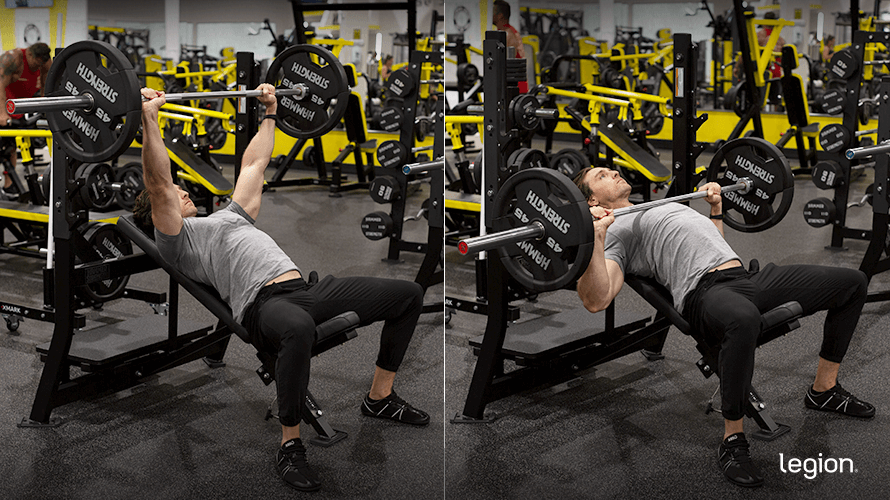
Why: The incline barbell bench press is the best chest exercise for training your “upper chest.” Including it in your chest workouts ensures you build proportionate chest mass, “filling out” your entire pecs.
How to:
- Lie on a bench angled at 30-to-45 degrees and plant your feet on the floor.
- Pull your shoulder blades together and down, and without lifting your butt or shoulders off the bench, slightly arch your back.
- Grab the bar with a slightly wider than shoulder-width grip and unrack the barbell.
- Lower the barbell to your upper chest, keeping your elbows tucked 6-to-8 inches from your sides.
- Press the bar back to the starting position.
Pro Tip: Think about snapping the barbell in half with your hands. The goal here is to maintain upper body rigidity, which helps you lift heavier weights safely.
Sets and Reps: 3 sets of 4-to-6 reps
Equipment: An incline bench press station or a squat rack with safety spotter arms and an adjustable bench, a barbell, and weight plates.
[Read More: Should You Incline Bench Press to Grow Your Upper Chest?]
3. Dumbbell Bench Press
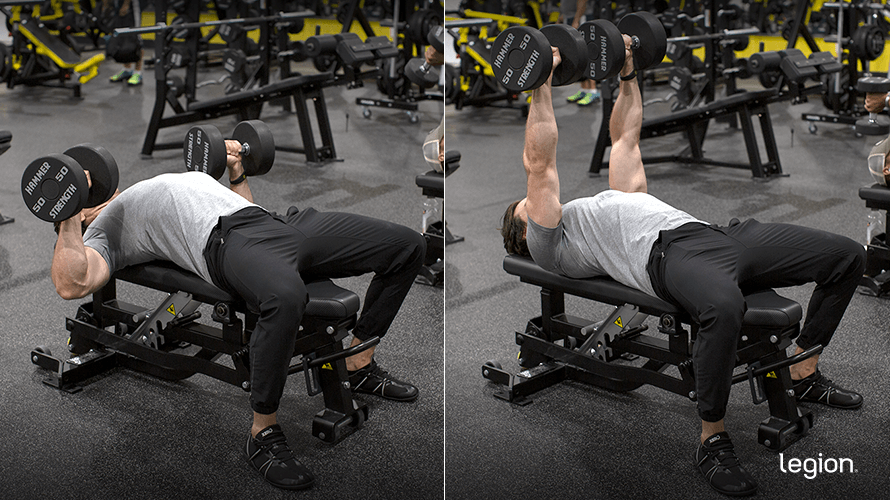
Why: The dumbbell bench press trains your chest similarly to the barbell bench press. The difference is the dumbbell variation allows you to use a greater range of motion, which benefits growth.
How to:
- While sitting on a flat bench, hold a dumbbell in each hand and rest them on your thighs.
- Lie back and bring the dumbbells up so you’re holding them on either side of your chest by giving them a nudge with your thighs.
- Press the dumbbells over your chest until your arms are straight and your elbows are locked.
- Lower the dumbbells to the starting position.
Pro Tip: Pull your shoulder blades back and down towards your back pockets to create a stable base and enhance stability and strength.
Sets and Reps: 3 sets of 4-to-6 reps
Equipment: A flat bench and a pair of dumbbells.
[Read More: How to Dumbbell Bench Press: Form, Benefits, and Variations]
4. Incline Dumbbell Bench Press
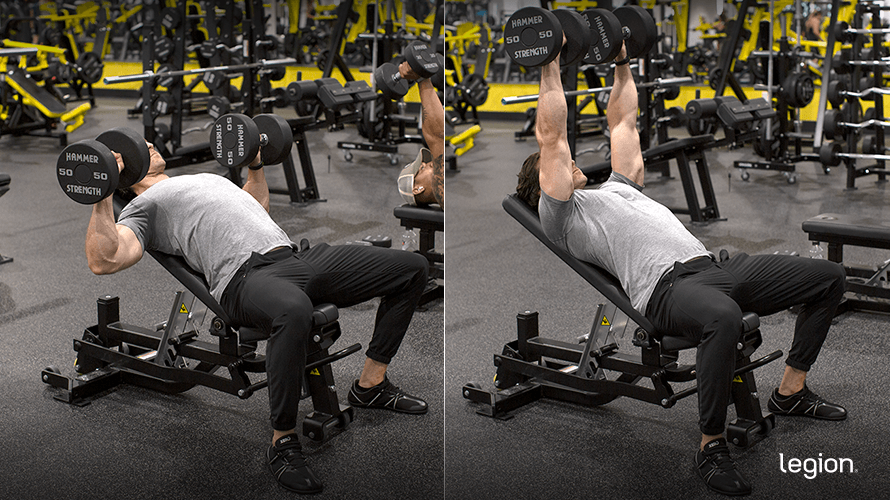
Why: The incline dumbbell bench press trains your chest (and particularly your “upper chest”), triceps, and shoulders in a similar way to the barbell version. It also allows you to train through a greater range of motion and stretch your chest muscles slightly more than the barbell bench press, which aids muscle growth.
How to:
- While lying on a bench angled at 30-to-45 degrees, hold a dumbbell in each hand and rest them on your thighs.
- Lie back, hoisting the dumbbells up so you’re holding them on either side of your chest by giving them a nudge with your thighs.
- Press the dumbbells over your upper chest until your arms are straight and your elbows are locked.
- Lower the dumbbells to the starting position.
Pro Tip: Set the bench to a 45-degree angle or lower to ensure your pecs do the majority of the work, not your shoulders.
Sets and Reps: 3 sets of 4-to-6 reps
Equipment: An adjustable bench and a pair of dumbbells.
[Read More: How to Create the Ultimate Upper Chest Workout]
5. Close-Grip Bench Press
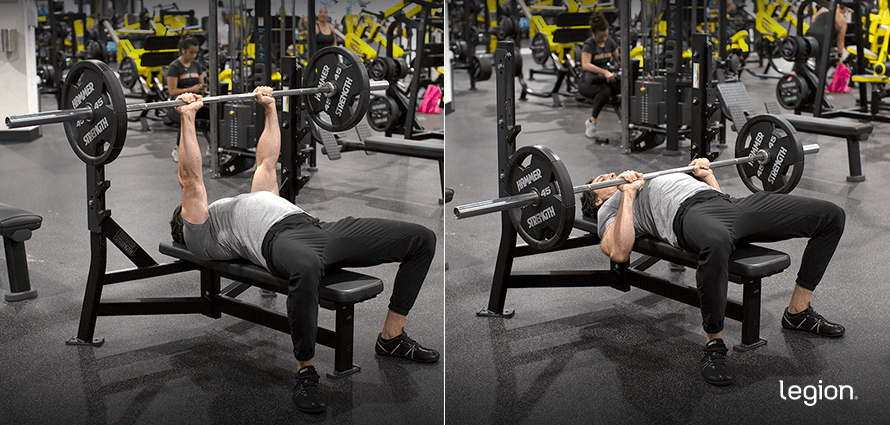
Why: The close-grip bench press is one of the best exercises for chest because it allows you to lift heavy weights safely, making it fantastic for building muscle and gaining strength.
How to:
- Lie on a flat bench and place your feet flat on the floor.
- Pull your shoulder blades together and down, and without lifting your butt or shoulders off the bench, slightly arch your back.
- Grip the barbell with a shoulder-width grip or slightly narrower and unrack the barbell.
- Lower the barbell to your lower chest, keeping your elbows tucked 2-to-4 inches from your sides.
- Press the bar back to the starting position.
Pro Tip: To optimize triceps engagement and protect your shoulders, keep your elbows tucked close to your body and lower the bar to your lower chest.
Sets and Reps: 3 sets of 4-to-6 reps
Equipment: A bench press station or a squat rack with safety spotter arms and a flat bench, a barbell, and weight plates.
[Read More: How to Close-Grip Bench Press: Tips & Variations]
6. Dip
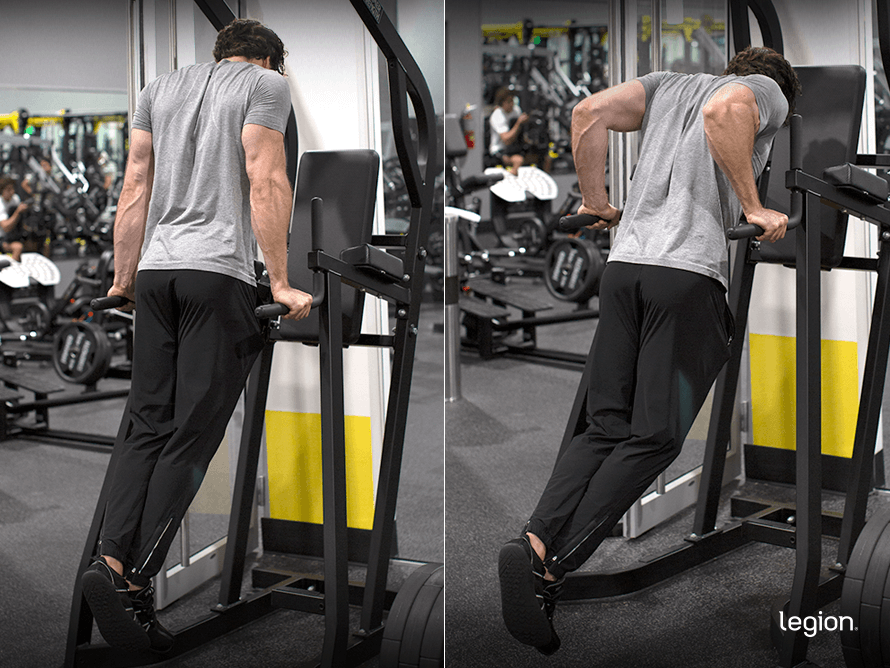
Why: The dip trains most upper-body muscle groups to a high degree, making it not just one of the best chest exercises for men and women but one of the best upper-body exercises overall.
How to:
- If you’re using a dip belt, wrap the chain around your waist, add the desired amount of weight to the chain, and fasten the carabiner.
- Grab both handles of a dip station, then press yourself up by straightening your arms and gently jumping off the ground so your arms are straight and supporting your entire body weight.
- Slightly bend your knees to keep your feet from touching the ground, then lower your body by bending your elbows until your upper arms are roughly parallel to the floor.
- Reverse the movement and return to the starting position.
Pro Tip: To emphasize the pecs, lean slightly forward while performing the dip.
Sets and Reps: 3 sets of 6-to-8 reps
Equipment: A dip station and a dip belt and weight plates if necessary.
[Read More: The Ultimate Guide to Chest Dips for Building Your Chest]
7. Dumbbell Floor Press
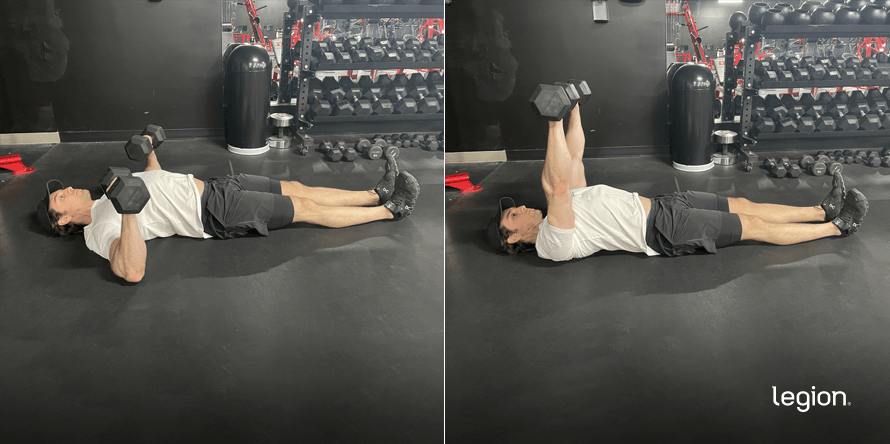
Why: The dumbbell floor press allows you to train your pecs with minimal equipment. Because the floor limits your range of motion, it’s also a viable bench press variation for those who experience shoulder discomfort with the regular bench press.
How to:
- While sitting on the floor, hold a dumbbell in each hand and rest them on your thighs.
- Lie back and hoist the dumbbells so you’re holding them on either side of your chest, and your triceps are in contact with the floor.
- With your palms facing your feet, press the dumbbells straight over your chest until your arms are straight and your elbows are locked.
- Reverse the movement and return to the starting position.
Pro Tip: Make the exercise safer and more effective by controlling the eccentric (lowering) portion of each rep to avoid “bouncing” your upper arms off the floor.
Sets and Reps: 3 sets of 6-to-8 reps
Equipment: A pair of dumbbells.
8. Dumbbell Pullover
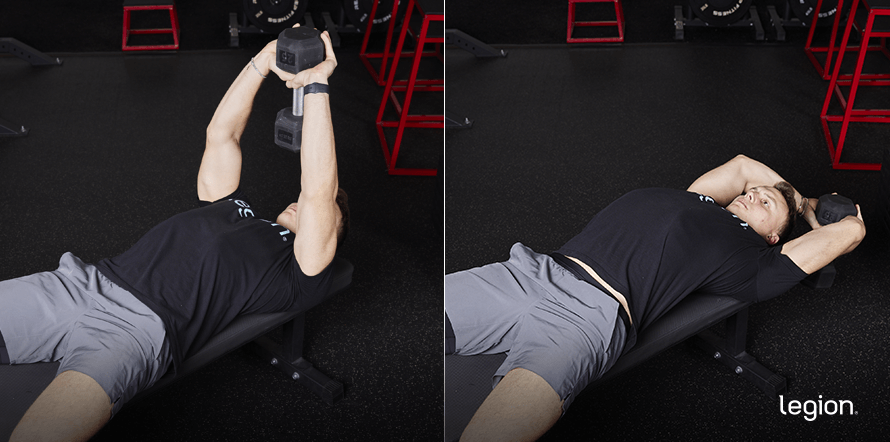
Why: The dumbbell pullover trains your pecs while stretched, making it one of the best chest exercises for adding mass to your pecs.
How to:
- While lying on a flat bench with your head as close to the end as possible, hold a dumbbell by one end with both hands over your chest.
- While keeping your elbows bent slightly, lower the dumbbell in an arc over your head until your biceps are next to your ears.
- Reverse the movement and return to the starting position.
Pro Tip: People typically report feeling their pecs more when they tuck their upper arms so that their elbows point to the ceiling when they extend their arms overhead.
Sets and Reps: 3 sets of 6-to-8 reps
Equipment: A flat bench and a dumbbell.
[Read More: How to Do the Dumbbell Pullover for Lats and Chest Size]
9. Push-up
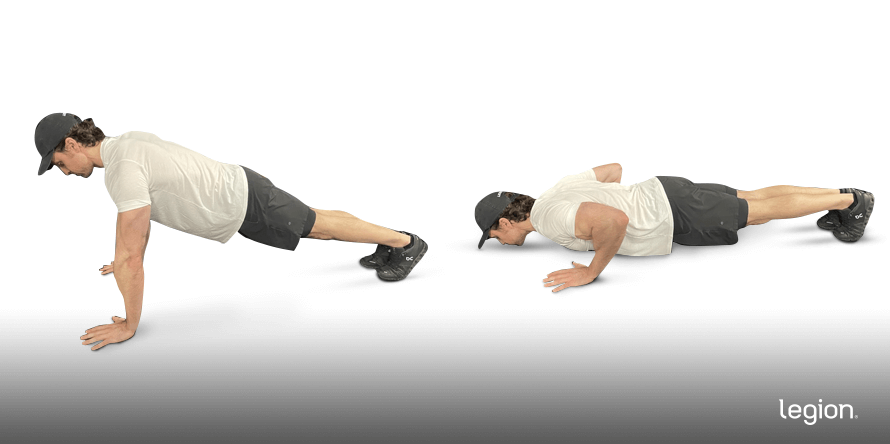
Why: The push-up is a fundamental chest exercise you can perform anywhere without equipment.
How to:
- Get on all fours and place your hands slightly wider than shoulder-width apart.
- Extend your legs behind you so you support your body weight on your hands and toes, and your body forms a straight line from your head to your feet.
- Lower your chest to the floor by bending your elbows, then push your body up and return to the starting position.
Pro Tip: If you’re not strong enough to do a regular push-up, start with a less challenging variation, such as knee or incline push-ups.
Sets and Reps: 3 sets of 10-to-20 reps
Equipment: A yoga mat if necessary.
[Read More: How to Do the Push-up: Form, Variations, and Workouts]
10. Resistance Band Push-up
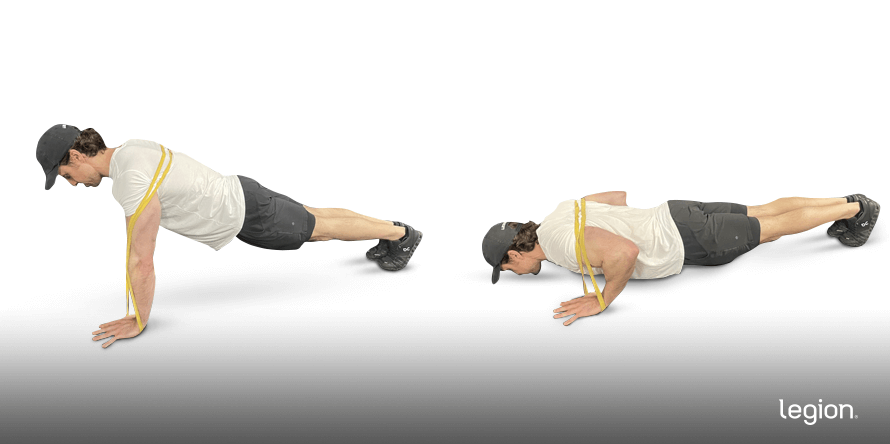
Why: Adding a resistance band to the push-up makes the exercise significantly more challenging, making it more effective for gaining muscle and strength.
How to:
- While holding one end of an exercise band in each hand, wrap the band around your back, just under your armpits.
- Get on all fours and place your hands slightly wider than shoulder-width apart.
- Extend your legs behind you so that your hands and toes support your weight and your body forms a straight line from your head to your feet.
- Lower your chest to the floor, then push your body up and return to the starting position.
Pro Tip: Ensure the band is in more or less the same position for every set and that it’s flat against your skin to prevent it from rolling or slipping.
Sets and Reps: 3 sets of 10-to-20 reps
Equipment: A resistance band.
[Read More: The Best At-Home Chest Workouts (with Bodyweight, Dumbbells, or Bands!)]
11. Deficit Push-up
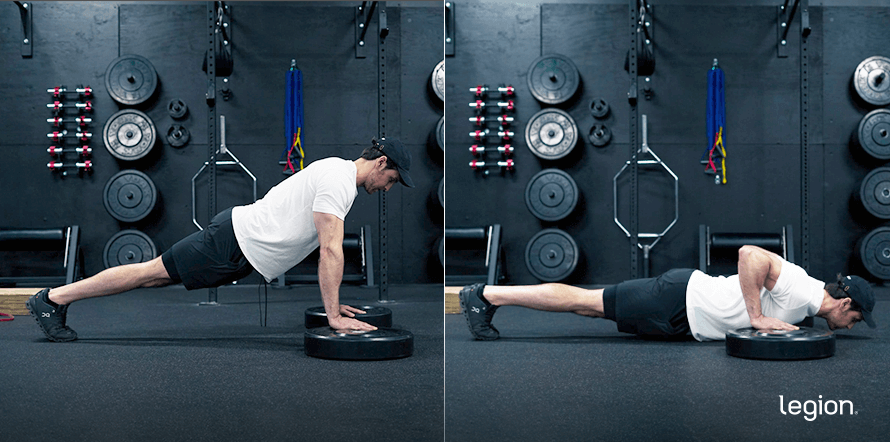
Why: The deficit push-up increases the range of motion compared to a regular push-up, thereby stretching the pec more deeply, making it an excellent choice for adding size to your chest.
How to:
- Place two dumbbells, steps, or weight plates on the floor shoulder-width apart.
- Get on all fours and place your hands on the elevated surfaces.
- Extend your legs behind you so you’re in a plank position, and your body forms a straight line from your head to your feet.
- Lower your chest to the floor, then push your body up and return to the starting position.
Pro Tip: Ensure whatever you put your hands on isn’t taller than 3-to-4 inches off the floor. Using objects higher than this makes the exercise easier, reducing its effectiveness.
Sets and Reps: 3 sets of 10-to-20 reps
Equipment: Two dumbbells, steps, or weight plates.
[Read More: The Best Push Day Workouts for Building Your Chest, Shoulders, and Triceps]
12. Decline Push-up
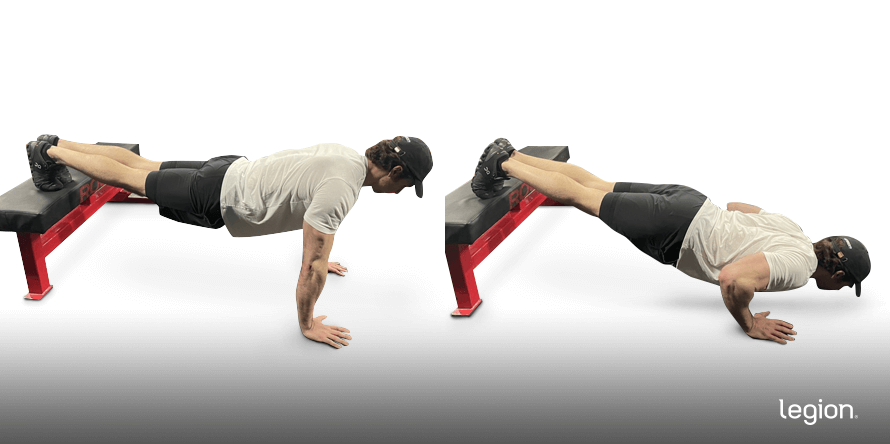
Why: The decline push-up is slightly more challenging than the regular push-up, so it’s a good chest exercise for when the regular version becomes too easy.
How to:
- Place your hands on the floor slightly wider than shoulder-width apart and rest your toes on a weight bench, chair, or other surface that’s about knee height off the floor.
- Straighten your back so your body forms a straight line from your head to your feet.
- Keeping your back straight, lower your chest to the floor.
- Push your body up and return to the starting position.
Pro Tip: Don’t rest your feet on an elevated surface much higher than knee height. Using something taller shifts the emphasis to the shoulders, which isn’t the purpose of the exercise.
Sets and Reps: 3 sets of 10-to-20 reps
Equipment: A knee-height bench, chair, or box.
13. Resistance Band Chest Press
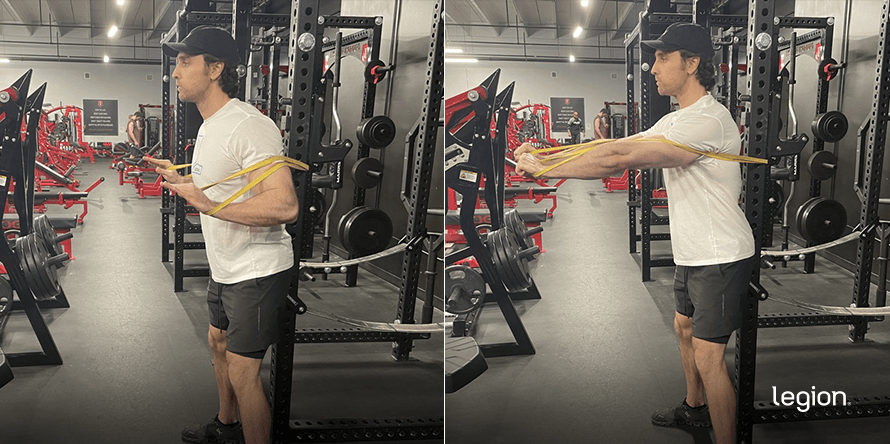
Why: The resistance band chest press is a good chest exercise for anyone who trains at home with minimal equipment or isn’t strong enough to do push-ups.
How to:
- Wrap a resistance band around a sturdy post, piece of furniture, or tree at about the height of your mid-chest.
- Turn your back to the post, grab hold of one end of the band in each hand, lift your hands to nipple height so that your elbows are slightly behind you and the band passes over the top of your triceps, and place your feet shoulder-width apart.
- Press the ends of the band straight out in front of your chest.
- Reverse the movement and return to the starting position.
Pro Tip: Increase the difficulty of the resistance band chest press by stepping further away from the object you wrapped the band around.
Sets and Reps: 3 sets of 10-to-20 reps
Equipment: A resistance band.
[Read More: The Definitive Guide to Resistance Band Workouts]
14. Dumbbell Fly
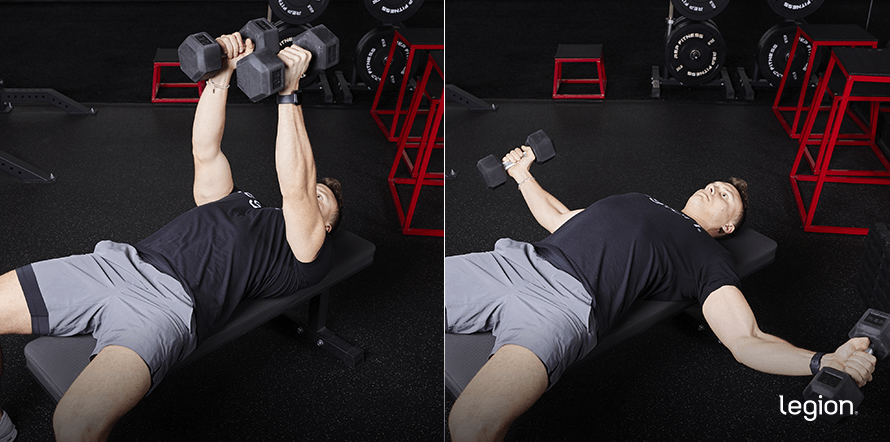
Why: The dumbbell fly is a highly effective chest isolation exercise because it trains your pecs when deeply stretched, which is important for maximizing muscle growth.
How to:
- While sitting on a flat bench, hold a dumbbell in each hand and rest them on your thighs.
- Lie back and bring the dumbbells up so you’re holding them on either side of your chest by giving them a nudge with your thighs.
- Press the dumbbells over your chest until your arms are straight and your elbows are almost locked.
- Lower the dumbbells in an arc out to your sides.
- Reverse the movement and return to the starting position.
Pro Tip: Keep a slight bend in your elbows throughout the movement to reduce the strain on your joints. Imagining hugging a yoga ball can help you maintain the correct arm position.
Sets and Reps: 3 sets of 10-to-15 reps
Equipment: A flat bench and a pair of dumbbells.
[Read More: The Ultimate Upper Body Dumbbell Workout for Arms & Chest]
15. Cable Fly
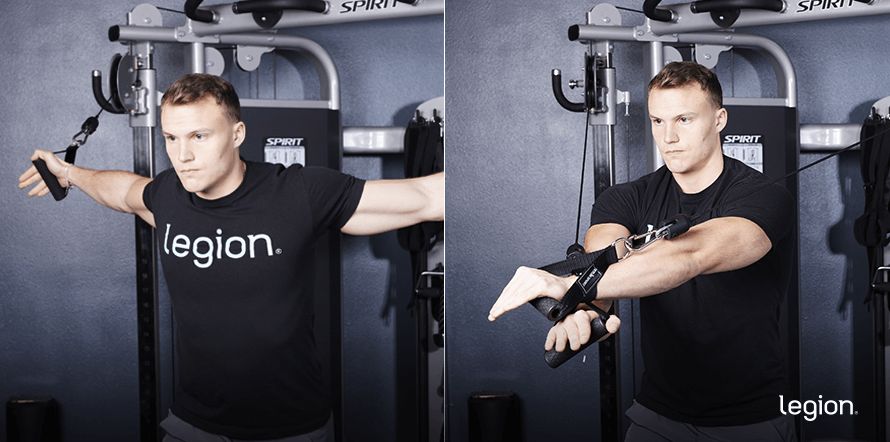
Why: The cable fly trains your pecs similarly to the dumbbell fly. The only difference is the cable fly keeps constant tension on your pecs throughout the entire range of motion, which may make it slightly better for gaining muscle.
How to:
- Adjust both pulleys on a dual cable machine to shoulder height and attach the single-handle attachments.
- Grab a handle in each hand and stand centrally between the pulleys so that the cables pull your arms out to your sides.
- Maintaining a slight bend in your elbows, take 1-to-2 steps forward so your arms are a little behind your torso with your palms facing forward.
- Keeping your elbows slightly bent, bring your hands toward each other in an arc.
- Reverse the movement and return to the starting position.
Pro Tip: Increase the range of motion by allowing your hands to cross over each other in front of your chest. If necessary, turn your wrists so your palms face down as your hands cross to prevent the handles from hitting each other.
Sets and Reps: 3 sets of 10-to-15 reps
Equipment: A cable machine.
[Read More: How to Do the Cable Crossover for Chest Size and Symmetry]
Best Chest Workouts: Exercises, Sets, and Rep Ranges
So far, we’ve focused on the best chest exercises; now let’s look at how to put these exercises into effective chest workouts.
Below are the best chest workouts using exercises from this article. They also contain the perfect amount of volume and intensity to spur growth without wearing you to a frazzle.
Chest Workout for Mass
Here’s a chest workout including the best chest exercises for men and women looking to add muscle to their upper bodies:
- Bench Press: 3 sets of 4-to-6 reps with 2-to-3 min rest
- Incline Dumbbell Bench Press: 3 sets of 4-to-6 reps with 2-to-3 min rest
- Dip: 3 sets of 6-to-8 reps with 2-to-3 min rest
- Cable Fly: 3 sets of 10-to-15 reps with 2-to-3 min rest
Chest Workout for Strength
This chest workout contains the best chest workout exercises for gaining raw strength:
- Bench Press: 3 sets of 4-to-6 reps with 2-to-3 min rest
- Incline Bench Press: 3 sets of 4-to-6 reps with 2-to-3 min rest
- Close-Grip Bench Press: 3 sets of 4-to-6 reps with 2-to-3 min rest
- Dip: 3 sets of 6-to-8 reps with 2-to-3 min rest
Chest Workout for Beginners
The following chest day workout contains the best chest exercise for those new to weightlifting:
- Dumbbell Bench Press: 3 sets of 6-to-8 reps with 2-to-3 min rest
- Incline Dumbbell Bench Press: 3 sets of 6-to-8 reps with 2-to-3 min rest
- Decline Push-up: 3 sets of 10-to-20 reps with 2-to-3 min rest
- Push-up: 3 sets of 10-to-20 reps with 2-to-3 min rest
And if you’d like more evidence-based chest workouts using barbells, dumbbells, bands, and body weight, check out this article:
The 5 Best Chest Workout Routines for Mass & Hypertrophy
What Are the Muscles of the Chest?
The pectoralis majors, or “pecs,” are the large, fan-shaped muscles of the chest. Here’s how they look:
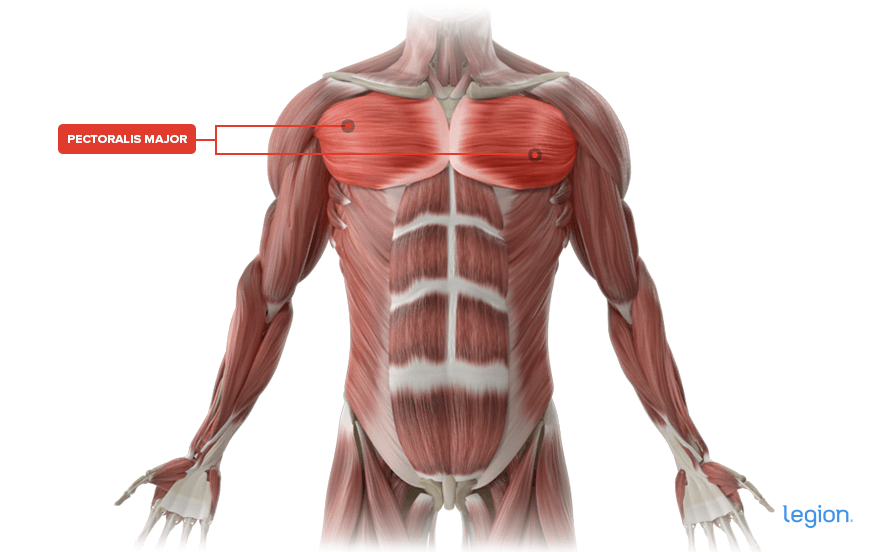
The pectoral muscles have two main sections or “heads:” the clavicular head, or “upper pec,” and the sternocostal head, or “mid and lower pec.”
Many scientists also divide the sternocostal head into two subsections: the manubrial portion, which makes up the bulk of the sternocostal head, and the abdominal portion, which is the small region at the bottom of the pec.
(Some scientists refer to the abdominal portion as the third head of the pecs, though not all agree.)
You can further divide these subsections into 6-to-7 segments. Here’s how all this looks on your body:
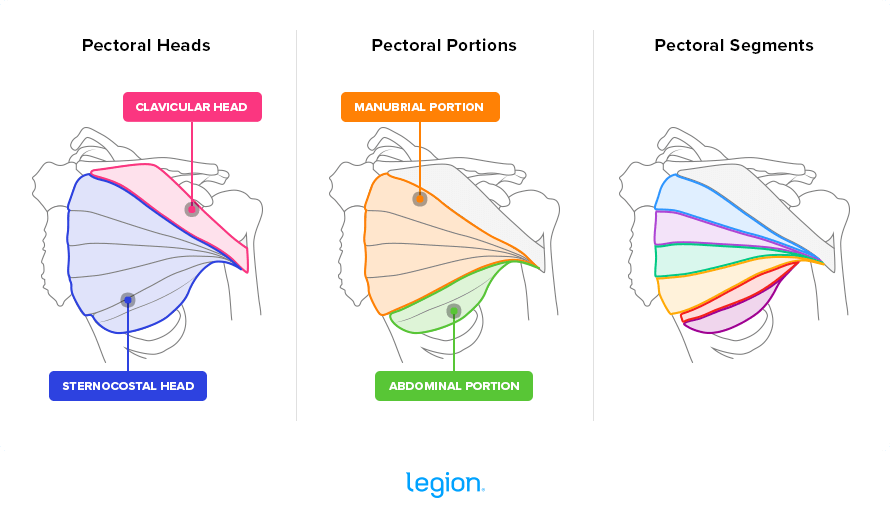
It’s important to note that while most people’s chest muscles resemble the diagram above, individual differences are common. According to some research, the pecs are six times more likely than any other muscle group to look and connect to your skeleton atypically.
This could mean that for you, any of the aforementioned heads, sections, and segments may be larger or smaller or more or less numerous than average (for example, some people have an “extra” pectoral head called a chondrocoracoideus).
The Benefits of Doing Good Chest Exercises
1. Functional Strength
Good chest exercises improve your day-to-day strength, making pushing open heavy doors, moving furniture, or getting up from the floor easier.
2. Upper Body Aesthetics
The pecs are one of the biggest and most prominent muscle groups in the upper body, which is why having a well-developed chest is paramount for a balanced, proportional, and attractive physique.
3. Enhanced Athletic Performance
Training your pecs with good chest exercises increases upper body power that’s vital for athletic activities that require pushing, throwing, or punching.
Best Exercises for Chest: FAQs
FAQ #1: Which chest exercise is most effective?
There’s no such thing as the “most effective” chest exercise since the effectiveness of a chest exercise can vary based on individual goals and fitness level.
However, most people regard the bench press as the best chest exercise because it allows you to lift heavy weights safely and progress regularly, making it ideal for building mass and strength.
FAQ #2: What are the only 4 chest exercises I need?
To train the chest from multiple angles and ensure balanced development, consider these four essential exercises: the flat bench press, incline bench press, dips, and dumbbell bench press.
FAQ #3: How can I get pecs fast?
Getting pecs fast requires hard training and proper dieting. Check out this article to learn everything you need to know:
The Best Way to Stimulate Muscle Hypertrophy (Build Muscle)
The post The 15 Best Chest Exercises for Strong, Developed Pecs appeared first on Legion Athletics.
https://ift.tt/NFDJaf3 March 25, 2024 at 06:00PM Legion Athletics
Comments
Post a Comment